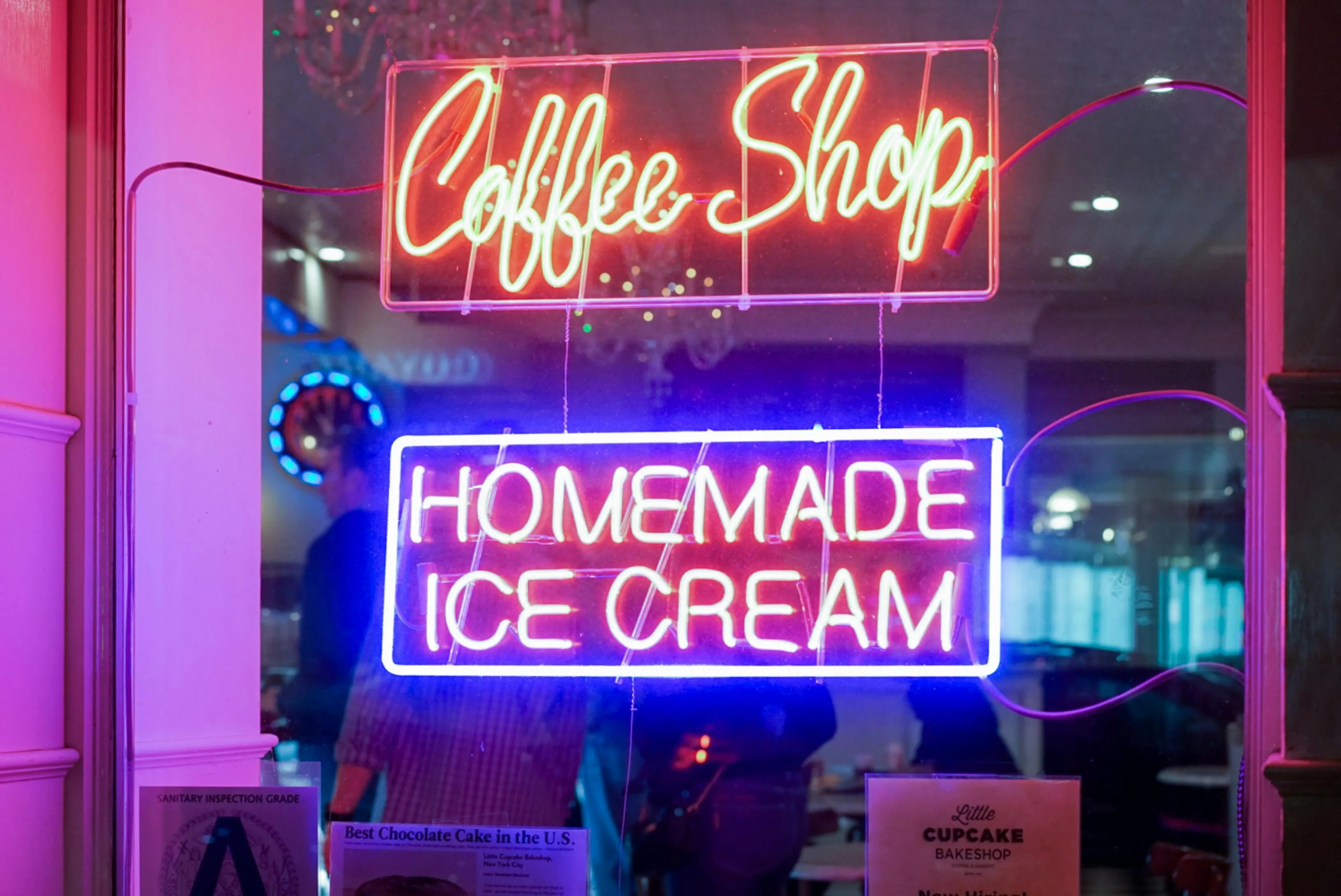Gas In Neon Lights? (Rare Gasses, Custom Effects, And Dangerous Effects)
Neon lights are known for their vibrant glow and iconic role in signage, art, and decor. But what is in a neon light that enables it to glow like it does? The answer lies in the gases used in neon lights.
In this guide, we explore how these signs work and what gases are used in neon signs. “Neon” is often used as a blanket term, as there are other gases in neon signs that contribute to their color and luminosity. Read on to learn how they safely illuminate spaces with glowing colors.

Key Takeaways
- Neon gas lights are illuminated by noble gases that glow when electrified inside sealed glass tubes.
- Neon gas emits a red-orange glow, but other colors can be achieved with gases like argon, krypton, and xenon.
- Gases in neon signs are often combined with coatings or colored glass for customized effects. Most gases in neon signs are inert and non-toxic.
- We supply high-quality custom LED neon signs that use a completely different technology to create a similar look with superior energy efficiency.
Table of contents
-
Gas In Neon Lights
-
What Kind Of Gas Is In Neon Signs?
-
What Gas Glows Purple In Neon Signs?
-
What Gas Makes Pink Neon?
-
Gas Used To Make Yellow Green Neon Signs
-
Which Noble Gases Are Used In Neon Lights?
-
What Gases Are Used For Custom Effects In Neon Signs?
-
Is Neon Gas Dangerous?
-
What Happens If You Break A Neon Light?
Gas In Neon Lights
The phrase “neon lights” is commonly used to describe a range of gas-filled illuminated signs, but not all of them contain neon gas. Traditional signs rely on various rare noble gases to produce their luminous glow.
The gas used in neon lights is excited by an electric current to cause it to emit light at specific wavelengths. Different gases produce different colors in this way, but “neon” has become the default term. Thus, when people ask what gas is in neon lights, the answer could be any of the noble gases commonly used in neon signs.
Understanding the gas in neon lights helps understand things like:
- Color variety
- Longevity
- Glow
From city skylines to cozy cafes, neon gas lights are used all around the world for ambiance and advertising. These signs remain popular for their nostalgic charm and modern alternatives like custom neon flex signs are growing in popularity.

What Gas Is Used In Neon Lights?
The gas used in neon lights is, unsurprisingly, neon. It is a colorless, odorless noble gas that was discovered in 1898. When you apply an electric current to a sealed tube with neon gas inside, the atoms become excited and emit a red-orange glow.
This is the signature color associated with classic neon gas lights. How neon signs glow revolves around this excitation process, transforming electrical energy into visible light. Neon itself only produces that red-orange hue, but the term “neon lights” has broadened to include other gases used in illuminated signs.
Neon is essential in authentic neon signage. Do all neon lights contain neon? No. Many of today’s “neon” signs use other gases or even LED technology. However, that traditional warm glow and vintage charm comes from the foundational neon gas technology.
What Kind Of Gas Is In Neon Signs?
Neon signs can contain a variety of noble gases, each of which produces its own signature glow when electrified. In addition to neon, common gases used in neon signs include argon, krypton, xenon, and helium.
Noble gases are ideal for signage due to their chemical stability and predictable behavior. The brightest neon sign gases depend on various factors, but here are some colors you can get:
- Soft lavender-blue: This is achieved by combining argon with a little mercury.
- Pinkish-red: You can get this color from helium.
- Pale violet or white: The color you get from exciting krypton atoms.
- Faint blue: Get this by using xenon gas.
The purity of the gas, pressure within the tube, and the type of glass or coating all influence the final appearance.
The combination of the gas used, the surrounding materials, and the electrical stimulations determine the color of a neon light.
What Color Does Neon Gas Produce?
If you don’t add any coatings or additives, neon gas produces a distinctive red-orange glow when electrified. This signature glow is iconic as it was what originally made neon signs famous. However, many people mistakenly believe neon gas can emit a full spectrum of colors.
In reality, you can only achieve other colors using different gases or colored glass. Do all neon lights contain neon? No, many use alternative noble gases to create different hues like:
- Blue
- Green
- Purple
If you seek authentic red-orange neon gas lights, that unmistakable color is unique to pure neon. If you want something different, you could work with us to create custom blue neon signs or select from a range of other colors. As our products use cutting-edge LED technology, there is a much wider spectrum of hues available.
Want a cutting-edge alternative to gas-powered neon signs?
Work with us to create custom LED signs that mimic the look of traditional neon signs with flexible tubing and an LED-powered glow that is more durable and energy efficient.
What Gas Glows Purple In Neon Signs?
The vivid purple you see in some neon signs can’t be created with neon gas alone. Instead, purple hues are usually produced using argon or krypton, sometimes enhanced with phosphor coatings inside the glass tube.
When these gases are excited by electricity, they emit ultraviolet light. The phosphor coating converts this UV light into a soft purple glow, allowing for more subtle and pastel-like purples than you could achieve with the gas alone.
Understanding what gas glows purple in neon signs helps explain how noble gases in neon lights are manipulated for aesthetic effect. This could help you create a cohesive color palette in a space alongside things like custom PVC giant balloons and painted backdrops.
If you are designing a custom sign and wondering how neon lights get their color, it’s usually a mix of the neon sign gas and specific coatings.

What Gas Makes Pink Neon?
Pink neon is a popular and eye-catching color. Color psychology tells us that it is commonly associated with romance, kindness, and femininity. But what gas makes pink neon? It’s usually a combination of neon gas and a colored glass tube, or sometimes argon mixed with mercury vapor inside phosphor-coated tubing.
Neon gas itself emits a deep red-orange glow. If you place it within a rose-colored tube, the resulting light can appear pink. Alternatively, the chemistry of neon lights can be manipulated using argon and mercury, resulting in UV light. This glows pink through phosphor conversion.
You can see how gas in neon lights interacts with various materials to alter perception. It’s also worth noting that neon gas lights rarely emit pink on their own - the gas type and external materials used create this color.
Get a custom LED neon sign that perfectly recreates the classic look
Use our service to create a custom red neon sign that accurately captures the iconic glow of retro neon signs without the fragile glass tubing or high-voltage operational needs.
Explore optionsGas Used To Make Yellow Green Neon Signs
Creating yellow or green neon signs takes more than just using different gases. It’s also about the way the gas interacts with the glass tubing. Let’s look at the facts about creating these colors:
- Yellow: Helium is often the gas used in neon signs for this, housed in a yellow-tinted tube.
- Green: Argon is typically combined with phosphor coatings or green-colored glass to create this hue.
When you consider the gas used to make yellow green neon signs, you must understand how the gases used in neon lights are combined with filters to achieve different colors. Green signs, for instance, may use a mix of mercury vapor and phosphors to create hues that combine well with green table covers and other matching decor.
So, what makes neon lights different colors? It’s the strategic combining of noble gases, glass types, and internal coatings.
Which Noble Gases Are Used In Neon Lights?
There are various noble gases used in neon signs to create the array of colors we associate with this glowing signage. Common ones include neon, argon, helium, krypton, and xenon, all of which are chemically stable and ideal for pumping into sealed tubes.
Each emits a distinct color when electrified:
- Neon: Red-orange
- Argon: Blue-violet
- Helium: pink or yellow-white
- Krypton: Pale lavender
- Xenon: Soft blue or grayish-white
These noble gases in neon lights are what determine color output, and the purity and pressure of the gas also impact brightness. With this variety, there is lots of scope for custom color creation in signage, contributing to the popularity of neon gas lights.
You can create an even wider array of colors if you create custom LED neon signs with us, and enjoy superior durability and energy-efficiency.
Need a neon sign that represents your brand or business?
With our service, you can create a custom logo neon sign that captures the colors and visuals of your brand perfectly. Hang in your store or bring it to a trade show to stand out.
What Gases Are Used For Custom Effects In Neon Signs?
To create special effects, manufacturers have to combine gases used in neon signs with colored glass or interior coatings. For example, argon and krypton can be used with phosphor powders to produce softer tones or pastels, or neon gas can be enhanced with rare gases or mercury to alter the hue.
Want a glowing blue or bright white? That’s often achieved with argon and mercury vapor, plus a special glass coating. These layers help convert UV light into visible colors, explaining how neon lights work chemically and how they get their color.
Neon sign gases can be layered or modified to achieve virtually any shade. Thus, it is often not just one gas that is used in neon signs, but a carefully-selected combination of noble gases and enhancements.
Is Neon Gas Dangerous?
When people ask if neon gas is dangerous, the short answer is no - under normal circumstances, neon signs are safe. Neon gas is an inert noble gas, so it doesn’t react chemically and is non-toxic. It’s one of the safest gases to use in neon signs.
However, some signs also include argon and a small amount of mercury vapor - this is particularly common in blue lights. Mercury can be hazardous if the tube breaks and the vapor is inhaled. That said, the amount used is minimal and it is sealed within the tubing.
Concerns about the dangers of gas in neon lights are usually exaggerated, particularly since these signs are designed for safe, long-term use. Nevertheless, if you are concerned about safety or simply want a more energy-efficient alternative, custom LED neon signs are the answer.
What Happens If You Inhale Neon Gas?
If you’re concerned about what happens if you inhale neon gas, rest assured that neon itself is entirely non-toxic. As a noble gas, it is chemically inert and doesn’t react inside the body at all. However, like all gases, it could pose a risk if it displaces oxygen in a confined space.
This risk is more theoretical than practical, however. Gas in neon lights is sealed inside durable tubes. Improper handling or industrial exposure to large quantities of neon gas lights could result in minor dizziness or shortness of breath from oxygen deprivation, but there is no record of this happening to anyone.
The gas used in neon signs is not considered harmful - it simply requires respect. If you were using the gas to make your own neon sign, ventilation is key during any exposure. Most modern neon signs are made with LED technology that doesn’t use any gases at all.

Create your own aesthetic in an energy-efficient LED neon sign
Work with us to create custom aesthetic neon signs with any combination of text and images. We offer an array of sizes, colors, and fonts to match your needs.
Get startedWhat Happens If You Break A Neon Light?
Breaking a neon light releases more than just glass shards - it could release some hazardous materials, depending on the neon sign gas used. If it’s a red-orange sign, it likely contains pure neon gas, which is inert and non-toxic.
However, some signs contain things like:
- Argon gas
- Mercury vapor
Mercury poses a health risk if it is inhaled in vapor form. That’s why it’s essential to handle broken neon gas lights with care. Always wear gloves, ventilate the area, and avoid vacuuming until you have removed all visible particles.
In most cases, a broken neon sign will do no harm - there are many examples of funny broken neon sign fails on the internet.
Frequently Asked Questions About Gas In Neon Lights
What Gas Is Used In Neon Lights?
The most iconic gas is neon, which produces a bright red-orange glow. However, gases used in neon lights can also include argon, helium, krypton, and xenon.
Is Neon Gas Considered Dangerous?
Neon gas is inert and non-toxic, so it is considered safe for use in signs. Be wary of signs that use mercury vapor, as this can be harmful if the tube breaks and you inhale it.
